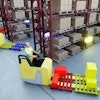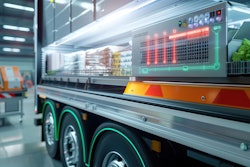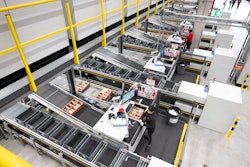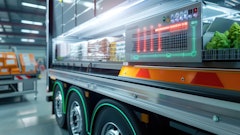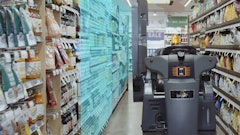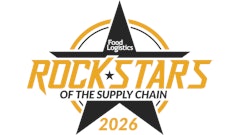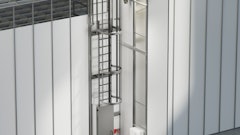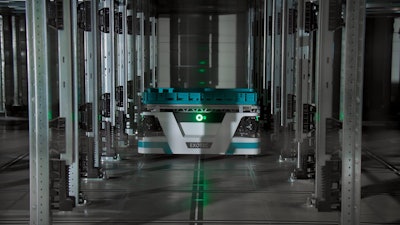
The future of warehouse automation involves emerging technologies, everything from artificial intelligence (AI) and cobots to predictive maintenance, robotics, augmented reality (AR), machine learning (ML) and more.
Present day, these automated systems are revolutionizing the way warehouses operate, driving efficiency, improving accuracy, reducing labor costs, increasing safety and more.
Food Logistics sat down exclusively with Andy Williams, EVP, Sales North America, Exotec, to discuss emerging technologies fit for the cold chain and the benefits of flexible storage and retrieval systems.
CLICK HERE to read Part 1 of this article in full. CLICK HERE to read Part 2 of this article in full. CLICK HERE to read Part 3 of this article in full.
Food Logistics: The future of warehouse automation involves emerging technologies, everything from AI and cobots to predictive maintenance and more. What are some of the key technologies and solutions every company in the cold food chain space must employ in order to future-proof their supply chains?
Andy Williams: The cold food supply chain is complex. Goods need to be stored and transferred at multiple different temperatures and warehouses require customized storage for smart refrigeration. Companies can integrate a combination of both automation technologies and software solutions in order to streamline some of these complexities and increase efficiency within their warehouses.
Some technologies to consider include software for real-time monitoring and traceability of goods, AI for forecasting, and automation systems like AS/RS that can improve storage density and shorten order preparation time.
Food Logistics: Breaking down a warehouse, what parts must be automated? What parts should be automated? And what parts are difficult to automate? And why?
Williams: Cold storage has strict compliance rules and automation is one way to guarantee that your company is meeting requirements at all times. Other areas that should be automated are places where you can see increased efficiency. A good place to start is to identify time-intensive, manual processes that eat up a lot of your team’s time. De-palletization and palletization are good places to start in cold storage. Businesses can easily automate this process, decreasing the time it takes for goods to be processed and to reduce potential errors.
Warehouse automation has advanced significantly in recent years, and most elements of the warehouse process can be automated. Of course, elements like return on investment and also ease of use/safety for operators must be considered. Difficulties typically arise when warehouse space becomes crowded or unavailable. We’re seeing systems shrink in overall footprint, but some solutions still require a minimum warehouse space. Vertical storage is more and more popular for that reason, since it significantly reduces warehouse space needed to deploy a complete system.
Food Logistics: What advice do you have for those companies who haven’t implemented any automation whatsoever or are just starting the journey? Where/how should they start?
Williams: First, truly evaluate the pain points you are facing in your warehouse. Are you having trouble sequencing your orders to make sure the pallets are properly stacked? Do you need a better process for packaging your products? How can we efficiently increase order fulfillment without sacrificing precision? Once you identify your key goals, then you can start looking into the solution that can fill these gaps within your warehouse. Make sure your strategy is based on a solid evaluation of the supply chain level goals and that your data/process that creates the business case for automation in a warehouse is well understood.
From there, set clear goals for the automation project and what would determine ROI. This allows the providers you are discussing with truly understand what you need so they can ensure they’re setting you up with the right system to meet your needs.
Food Logistics: Within the last 12 months, what technologies or solutions has your company introduced?
Williams: On Feb. 6, we announced the evolution of our product, The Next Generation of Skypod system. The system actually first stemmed from a challenge from one of our grocer customers E Leclerc Seclin. After the global pandemic, they saw a huge uptick in customers doing curbside pickup. As the amount of customers increased, they needed a better way to balance the flow of goods and customers for pick up.
We provided them with a high-density, flexible storage and retrieval system with a number of key benefits to increase efficiencies. For example, the Next-Gen Skypod system’s Integrated Buffer allows for efficient order storage and ensures quick reactivity, optimizing space within their site while accommodating the different temperature requirements various goods may need. Further, our robots are capable of handling both cold and ambient temperatures without the need for additional hardware. Customers can confidently shop online knowing the items they receive when they come to pick up are fresh and they’ll receive their goods in a timely manner. Initial results are incredible; they’ve seen a 73% reduction in customer wait time from 15 minutes to 5 minutes.
As the R&D process evolved, the team quickly realized many of the new, value-added features would be beneficial to different types of warehouses. This resulted in the final version of our newest innovation, the Next Generation of Skypod system that is currently being deployed in warehouses globally.
Food Logistics: What are some things not addressed above that may be pertinent to our cold food chain readers?
Williams: Automation is table stakes in many industries in order to maintain competitive advantage. Grocers like E. Leclerc Seclin are ultimately demonstrating what’s possible when you rethink your supply chain through the lens of technology. After integrating the AS/RS system, they saw a 50% increase in daily customer orders and a 73% reduction in customer waiting time. This is just one example of how increasing technology completely reduces the difficult elements of cold storage supply chains, allowing businesses to focus on other elements of the work and for customers to be more confident stores are stocked with the items they need the most, when they need them.. It’s truly a win-win addition to these warehouses.
CLICK HERE to read Part 1 of this article in full. CLICK HERE to read Part 2 of this article in full. CLICK HERE to read Part 3 of this article in full.


